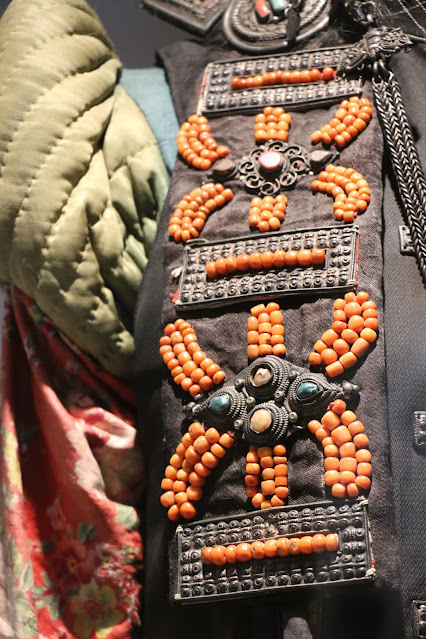Fortunately the rain held off while we walked from the Monastery to the National Museum. On the way we stopped for some Buuz. (Mongolian dumplings). Conveniently, there was a Buuz eatery close to the State Department store.
The heavens opened just as we got to the National Museum. Perfect timing for the next few hours.The ground floor had lots of interesting ancient artefacts in stones, rocks, and copper, but my interest was on the first floor, the costumes of the different districts of Mongolia.
There are over 20 ethnic groups in Mongolia. Each group has it's own traditional clothing an ornaments, reflecting their culture and traditions. Most Mongolians wear a del, a silk garment with buttons on the right and a high collar. The top part of the del slants across the chest, the lower portion is rather loose. Traditionally del have long sleeves ending with wide cuffs. The del are lined with camel, yak, or goat (cashmere) hair for insulation.
Mongolian clothing is divided into three categories: Everyday clothes, Ceremonial clothes, and Official clothes.
Kazak, is the western part of Mongolia, and are a Turkish ethnic group. The embroidery on their clothes are complex geometric shapes.
The Barga is an ancient tribe of Mongolia. They live in Gurvanzagal and Khölönbuir of Dornod aimag, the sum (district) of Dornod Province in eastern Mongolia, as well as the Inner Mongolia Autonomous Region in China.
Female Kazak garment
Details on a male Kazak garment.
The Barga is an ancient tribe of Mongolia. They live in Gurvanzagal and Khölönbuir of Dornod aimag, the sum (district) of Dornod Province in eastern Mongolia, as well as the Inner Mongolia Autonomous Region in China.
Barga garment - look at those boots!
The Dariganga ethnic group moved to the Darigana region in 1697, and reside in the Sukhbaatar province in south eastern Mongolia.
Dariganga garment
The Buryad Mongolian ethnic group, live in the northern part of Mongolia. Their garments are heavily embroidered.
Detail of Buryad embroidery on garmentBuryad garment
Details of beading on Myangad garment - I think the orange beads are coral.
The Torguud ethnic group live in the Khovd province on the board of China's Xinjiang region.
Details of the embroidery on the sash of the Torguud garment
Ceremonial costume for a state Official (17th Century)
The rest of the museum had a fascinating collection of Mongolian history, and the design of the museum led you to the next section. Allow at least 2 hours to view.























No comments:
Post a Comment